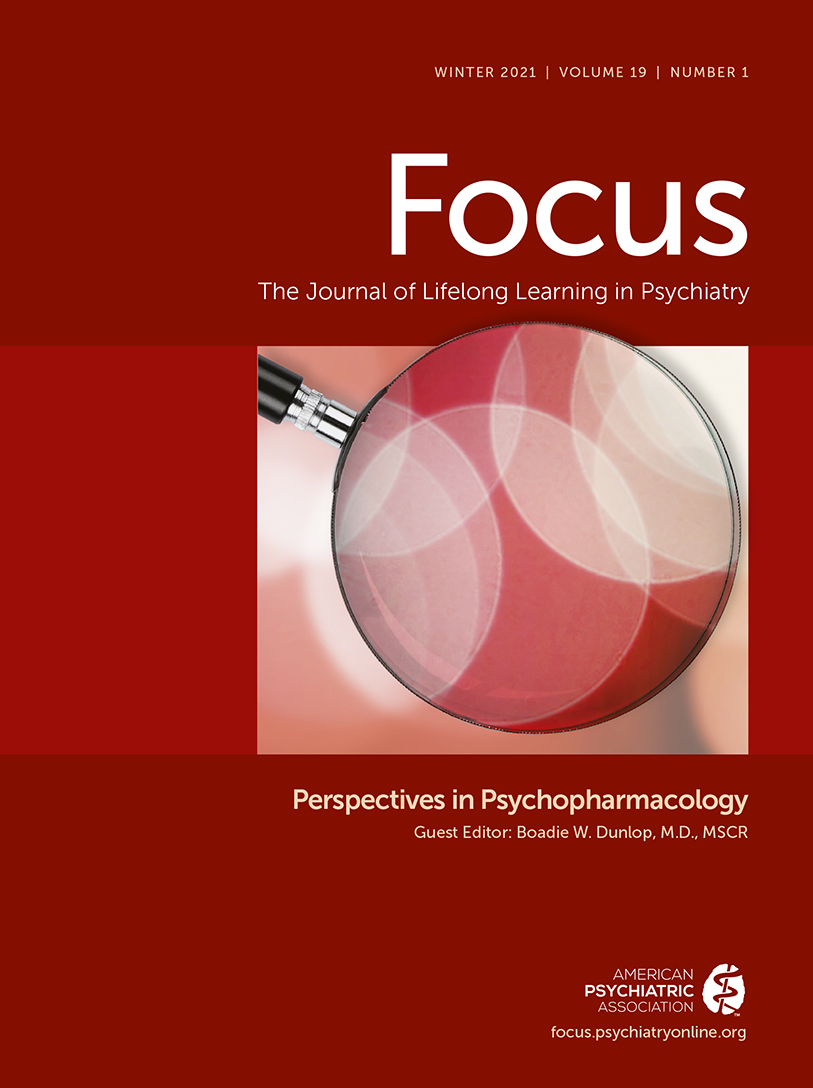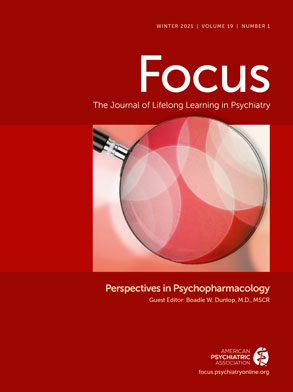For patients whose depression has not been responsive to selective serotonin reuptake inhibitor or serotonin-norepinephrine inhibitor treatment and for whom treatment with a monoamine oxidase inhibitor seems warranted, how best can the drug-free interval required by the Food and Drug Administration for such a transition be managed?
Estimates indicate that 15%−20% of patients presenting for treatment of major depression require monoamine oxidase inhibitor (MAOI) treatment for optimal response, but the rate of prescription of MAOIs in the United States in 2005 was less than 0.1% (
1). A 1999 survey found that 40% of psychiatrists had not prescribed an MAOI in the previous 3 years, and only 2% of psychiatrists prescribed them frequently (
2); these numbers have certainly worsened since then, as older psychiatrists have retired. These low rates are even more remarkable considering the easing of the dietary restrictions to be followed while on MAOI therapy (
3). This problematic reluctance on the part of patients and providers clearly needs to be addressed. In our experience, this reluctance stems in part from fears of patients worsening in the period between discontinuation of current antidepressants and initiation of the MAOI. However, once the decision to try an MAOI is made, the transition is rarely difficult and need not require any interval off treatment.
MAOIs are among the oldest medications in the psychiatric pharmacopeia, with demonstrated efficacy in unipolar and bipolar depression, social anxiety disorder, posttraumatic stress disorder, and panic disorder. The four MAOIs approved in the United States for depression are phenelzine, tranylcypromine, isocarboxazid, and transdermal selegiline (
4), which all irreversibly inhibit monoamine oxidase (MAO). Phenelzine, isocarboxazid, and tranylcypromine inhibit both MAOA (which degrades serotonin, norepinephrine, and dopamine) and MAOB (which degrades dopamine) throughout their dose ranges. Transdermal selegiline is selective for MAOB at low doses and inhibits MAOA to a therapeutic degree at a dosage of at least 6 mg every 24 hours.
The two primary safety concerns with MAOI treatment are a hypertensive crisis reaction and serotonin syndrome. Hypertensive crises can arise from the pharmacodynamic interaction of MAOIs with sympathomimetic drugs or excessive dietary tyramine intake. Serotonin syndrome occurs when medications that enhance serotonin availability (primarily the serotonin reuptake inhibitors [SSRIs] and serotonin-norepinephrine reuptake inhibitors [SNRIs]) are taken when MAO activity is inhibited. Because of these risks, MAOIs are not typically considered as a treatment option for patients until several other treatments have failed. However, this scenario presents the complications of transitioning to an MAOI from an existing regimen, which may be complex and include medications contraindicated with MAOIs.
It is important to briefly consider why such a switch may make sense in a given case. Uptake-inhibiting antidepressants are all similar in their primary mechanism of action, whereas MAOIs have a primary mechanism of action that is completely different from that of antidepressants that are in wide general use. Rather than induce prolonged accumulation of serotonin and norepinephrine in the intrasynaptic clefts throughout the brain, as do SSRIs, SNRIs, and tricyclic antidepressants, MAOIs, by inhibiting MAO, have the effect of increasing the stores of presynaptic monoamines available for release into the synapse as regulated by processes such as feedback inhibition. These presynaptic stores include not only serotonin and norepinephrine but also the behaviorally salient monoamine dopamine, a deficit of which may have an important role in persistent depressive symptoms such as apathy, psychomotor retardation, and anhedonia (
5).
Rather than waiting for numerous medication failures before beginning an MAOI, an assessment of the patient’s symptom picture can warrant earlier initiation of this class of medication (
6). MAOIs have been demonstrated to have superior efficacy to tricyclic antidepressants for depression characterized by atypical features (
7,
8). Atypical depression includes mood responsivity to positive events at a level of at least 50% along with at least two of the following: an excessive need for sleep, hyperphagia, prominent lethargy or anergia, and a long-standing pattern of oversensitivity to personal rejection. A variant of atypical features that does not focus on rejection sensitivity but emphasizes the reverse neurovegetative symptoms of hypersomnia, hyperphagia, anergia and loss of motivation also shows good response to MAOIs (
9).
When a prescriber decides to move a patient who is on a serotonin reuptake inhibitor to an MAOI, the question becomes how to make the transition safely, balancing the competing risks of potential drug interactions against the risk of a period without antidepressant coverage and clinical deterioration. Approaching this problem is made more complex by the highly restrictive guidance on the MAOI product labels approved by the Food and Drug Administration (FDA), compared with the more flexible recommendations of experts with deep clinical experience with MAOIs.
The FDA labels for the marketed MAOIs state that sympathomimetic drugs, such as stimulants, and the 5-HT1a receptor antagonist buspirone are contraindicated because of hypertensive risks (
10–
13). Tryptophan supplements, certain opiates, and dextromethorphan are contraindicated because of the risk of serotonin syndrome. Antidepressants as a class, and regardless of mechanism of action, are listed as contraindicated because of serotonin syndrome risk, and some are contraindicated for hypertensive risk. This restriction includes drugs that have no direct action on serotonin as well as agents that act by antagonizing serotonin receptors but not transporters, such as mirtazapine. The restriction also extends to carbamazepine and oxcarbazepine because of their shared dibenzoazepine structure with tricyclics. Lithium is listed as “use with cautions” on the tranylcypromine label, a dubious warning that is appropriately absent from the labeling of other psychotropics. Such broad restrictions make it difficult to transition a patient to an MAOI from an existing antidepressant regimen. In contrast, the first author has used bupropion, mirtazapine, and trazodone in combination with MAOIs for many years with no adverse consequences, as have many members of the international MAOI experts group (
maoi-expert-group@googlegroups.com).
Other medications less commonly considered to carry risk with MAOIs include blood-pressure-lowering agents, which may act synergistically with the hypotensive side effect sometimes observed on initiating an MAOI and carry warnings on the tranylcypromine and isocarboxazid labels. Thus, particular attention should be paid to such drugs used in psychiatry, including alpha-1 antagonists such as prazosin and certain antipsychotics, alpha-2 agonists such as clonidine and guanfacine, and beta blockers, such as propranolol. The tranylcypromine label also asserts that nonselective histamine type 1 receptor antagonists, such as diphenhydramine, are contraindicated because of increased anticholinergic effects, and triptans, such as sumatriptan, which agonize serotonin type 1B and 1D receptors, are contraindicated because of the risk for serotonin syndrome (
12). These additional contraindications on the tranylcypromine label are not well supported by the literature and not present on the labels of transdermal selegiline or phenelzine.
Regarding the duration of the drug-free interval, the FDA labels state that contraindicated medications, including antidepressants, should be discontinued for at least four to five half-lives of the parent drug, or any active metabolites, before initiating an MAOI. For most antidepressants this means about 5–7 days, although 2–3 weeks are required for vortioxetine and 5 weeks for fluoxetine. Antidepressants with most rapid clearance are venlafaxine (3 days) and desvenlafaxine (2 days).
The Transition
Our recommended strategy for the shift from a failed course of treatment with an SSRI or an SNRI to an MAOI is to introduce an antidepressant with no dangerous MAOI interaction while the failed medication is being tapered. Safe antidepressant options include mirtazapine (
14), trazodone (
15), and tricyclics other than clomipramine or imipramine (
16); nortriptyline is one we often use. If this step brings the patient to recovery, no further measures need be taken, and an MAOI will not be required. However, if after an adequate trial of the added antidepressant, or some combination of the permissible agents, there has not been a satisfactory clinical response, an MAOI can be initiated. The dose of the MAOI can be increased following the usual dosing strategy concurrently with the tapering of the safe medications. Notably, if there has been a partial but worthwhile response to the transitional medications, they can be retained throughout MAOI therapy. With a tricyclic such as nortriptyline, this is particularly sensible because there is greater safety in adding an MAOI to an established tricyclic antidepressant than vice versa.
Notably, if in addition to an SSRI or an SNRI the patient is on one or more antidepressant adjuncts, such as aripiprazole, quetiapine, triiodothyronine, gabapentin, pregabalin, lamotrigine, or a benzodiazepine, these agents can be continued unchanged. Leaving them in place may make the period preceding MAOI initiation less uncomfortable. In contrast, the old practice of prescribing a “rescue” rapid-acting blood-pressure-lowering agent (e.g., nifedipine) to be taken by the patient in the case of symptoms of a hypertensive reaction is no longer recommended because of the established serious risks of brain, cardiac, and renal hypoperfusion stemming from an acute blood pressure reduction.
A point worth making is that instead of an unpleasant discontinuation syndrome, we have occasionally observed that some patients experience a period of mild elation on discontinuation of a monoamine reuptake inhibitor such as paroxetine or duloxetine. This experience rarely lasts more than 2 weeks before mood sinks back into depression. So, in cases in which the antidepressants that are safe to combine with MAOIs have previously been tried and failed, such that the bridging strategy is not possible, or if a patient prefers to move straight from the unsatisfactory current regimen to a trial of an MAOI, they can be advised that it is possible their mood may brighten for a short time after coming off the reuptake inhibitor. If instead they slump in mood, then a brief course of treatment with a benzodiazepine, gabapentin, or low-dose quetiapine may make the washout period more tolerable.
A final precaution: Tapering off SSRIs and SNRIs, particularly paroxetine or venlafaxine, even gradually, may be associated with such acute dysphoria that the patient is strongly inclined to just go back on the unsatisfactory agent rather than pursue the well-being that MAOIs offer. In such cases, it is critical to make clear to the patient that this is not a recurrence of depressive illness but an acute discontinuation syndrome. Therefore, returning to the agent being discontinued would not relieve depressive illness, which would not have acute onset but rather would have slowly crept up with the passage of time off effective treatment. In these cases, a slower SSRI or SNRI taper, along with the addition of a safe transitional medication, is the best approach to enable the patient to reach the potential benefit of an MAOI trial.

